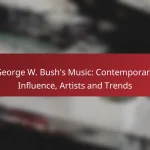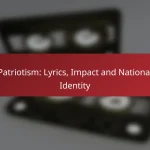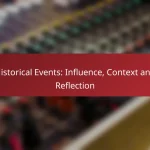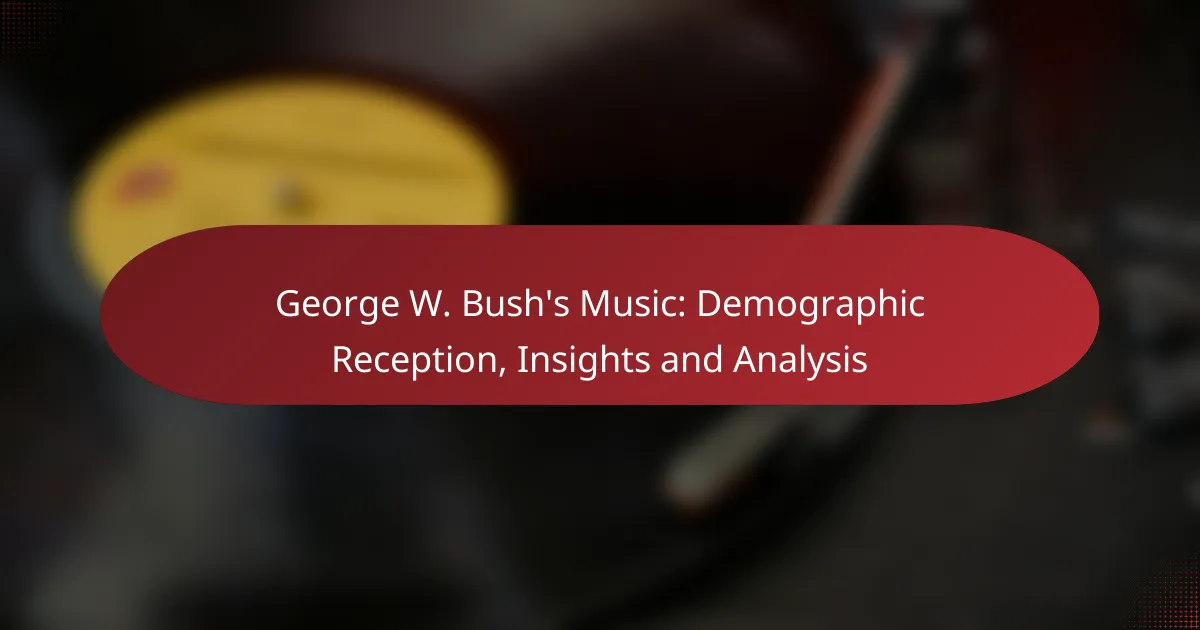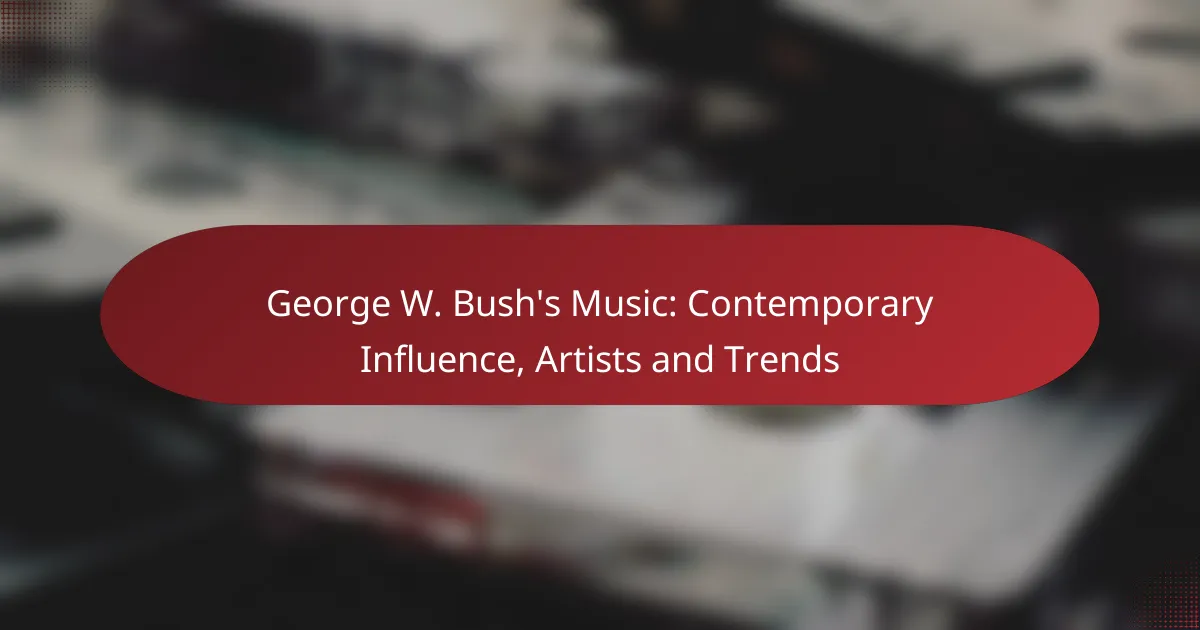George W. Bush’s music selections played a significant role in shaping his public persona, particularly among conservative audiences who resonated with the patriotic themes prevalent in his choices. His musical preferences not only reflected his personal taste but also underscored the cultural significance of Americana, aligning closely with the values and sentiments of his political base during his presidency.
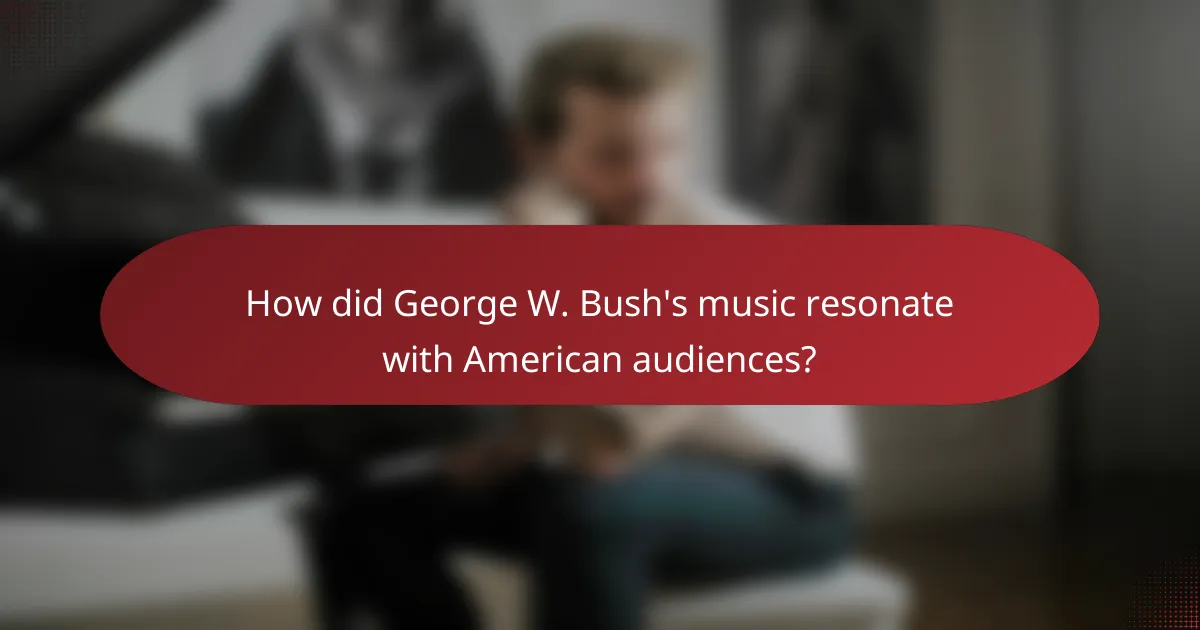
How did George W. Bush’s music resonate with American audiences?
George W. Bush’s music resonated primarily with conservative audiences, reflecting their values and sentiments during his presidency. His musical choices often aligned with patriotic themes, which appealed to a significant portion of the American public.
Popularity among conservative demographics
Bush’s music selection, including country and classic rock, found a strong following among conservative demographics. Artists like Toby Keith and Lee Greenwood, who often express patriotic sentiments in their songs, were particularly popular during his administration.
Concerts and events featuring these artists often drew large crowds, reinforcing the connection between Bush’s political image and the musical tastes of his supporters. This alignment helped solidify his appeal within this demographic, making music a tool for political engagement.
Impact on younger listeners
Younger listeners had a mixed reception to Bush’s music, with many gravitating towards genres like hip-hop and pop that contrasted with his musical preferences. While some appreciated the patriotic overtones, others viewed the music as outdated or disconnected from their experiences.
Despite this, certain songs became anthems for youth movements, particularly those focused on social issues, showcasing a complex relationship between Bush’s music and younger audiences. This divergence highlights the generational gap in musical tastes during his presidency.
Regional variations in reception
The reception of Bush’s music varied significantly across different regions of the United States. In the South and Midwest, where country music thrives, his musical choices were generally well-received and celebrated at public events.
Conversely, in urban areas and the Northeast, where diverse musical influences dominate, Bush’s music faced more skepticism. This regional disparity illustrates how local culture and musical preferences shaped the overall reception of his musical selections.

What insights can be drawn from George W. Bush’s musical choices?
George W. Bush’s musical preferences reflect a blend of personal taste and cultural significance, particularly highlighting themes of Americana and patriotism. His choices often resonate with traditional values and the sentiments of his political base, providing insights into his identity and leadership style.
Influence of country music
Country music played a significant role in shaping George W. Bush’s musical landscape, aligning with his image as a Texas native and a representative of rural America. Artists like Alan Jackson and Toby Keith, who often incorporate themes of family, hard work, and resilience, were favorites during his presidency.
This genre’s storytelling aspect resonates with many Americans, making it a powerful tool for connecting with his audience. Bush’s affinity for country music also reflects broader demographic trends, as this genre enjoys substantial popularity among conservative voters.
Connection to American patriotism
Bush’s musical selections often emphasized American patriotism, particularly in the wake of the September 11 attacks. Songs that celebrate national pride and unity, such as Lee Greenwood’s “God Bless the USA,” became emblematic of his administration’s response to national crises.
This connection to patriotism was not only about personal preference but also served as a strategic move to rally support and foster a sense of community among Americans. By choosing music that evokes feelings of pride and resilience, Bush reinforced his political messages and connected with the emotional landscape of the nation during his presidency.
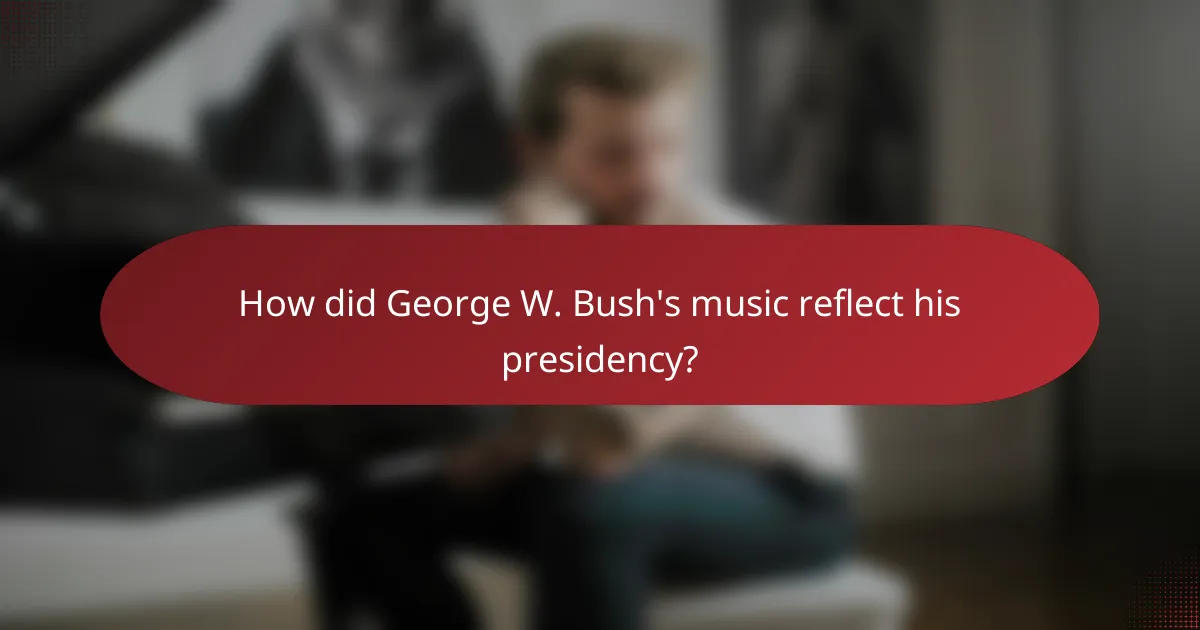
How did George W. Bush’s music reflect his presidency?
George W. Bush’s music choices mirrored his presidency by emphasizing themes of patriotism, resilience, and unity during challenging times. His selections often resonated with the American public, reflecting the sentiments of the nation in the wake of significant events.
Musical themes during key events
During pivotal moments such as the September 11 attacks and the subsequent wars in Iraq and Afghanistan, Bush’s music selections included songs that evoked feelings of strength and solidarity. For example, he often played “God Bless the U.S.A.” by Lee Greenwood, which became an anthem of national pride and resilience.
In contrast, during times of economic downturn, the music he chose tended to focus on hope and recovery, with songs that encouraged perseverance. These thematic choices were not just entertainment; they served to bolster public morale and foster a sense of community during turbulent times.
Symbolism in song selections
The songs selected by Bush often carried symbolic weight, representing core American values. For instance, the inclusion of country music reflected his Texan roots and appealed to a broad demographic, reinforcing his image as a relatable leader.
Additionally, songs like “The Rising” by Bruce Springsteen symbolized the spirit of recovery and resilience after 9/11, aligning with his administration’s messaging. Such selections were carefully curated to resonate with the emotions of the American people, creating a soundtrack that complemented his presidency’s narrative.

What demographic factors influenced the reception of Bush’s music?
The reception of George W. Bush’s music was significantly influenced by demographic factors such as age and political affiliations. These elements shaped listeners’ preferences and perceptions, leading to varied responses across different groups.
Age-related preferences
Younger audiences often gravitated towards pop and hip-hop genres, while older listeners showed a preference for classic rock and country music, which were more aligned with Bush’s musical selections. This generational divide resulted in contrasting receptions, with younger listeners sometimes dismissing his music as outdated.
Moreover, the nostalgia factor played a role; older demographics tended to appreciate music that resonated with their formative years, while younger listeners sought contemporary sounds. This divergence highlights how age-related preferences can shape the overall reception of an artist’s work.
Political affiliations and music taste
Political affiliations heavily influenced how different groups received Bush’s music. Supporters of Bush often embraced his musical choices, viewing them as a reflection of their values and beliefs. Conversely, critics and opponents were more likely to reject his music, associating it with his political agenda.
This polarization can be seen in concert attendance and album sales, where events aligned with Bush’s political stance attracted enthusiastic supporters, while those opposing him often boycotted. Understanding these dynamics is crucial for analyzing the broader impact of political context on music reception.

How did media coverage shape perceptions of Bush’s music?
Media coverage significantly influenced how audiences perceived George W. Bush’s music, often framing it within the context of his presidency and political persona. Coverage varied widely, with some outlets praising his musical choices while others criticized them, shaping public opinion and reception.
Analysis of major news outlets
Major news outlets played a crucial role in shaping perceptions of Bush’s music by highlighting specific performances and song selections. For instance, outlets like CNN and The New York Times often focused on the emotional resonance of his music during key political moments, which helped to humanize him as a leader. In contrast, more critical publications pointed out the disconnect between his musical tastes and the broader cultural climate.
Coverage also varied by political alignment, with conservative outlets generally portraying his music in a favorable light, emphasizing its patriotic themes. This divergence in portrayal contributed to a polarized view of Bush’s musical identity among the public.
Social media reactions
Social media platforms became a battleground for opinions on Bush’s music, with users sharing their thoughts and reactions in real-time. Many users expressed nostalgia for his musical choices, particularly during moments of national crisis, while others mocked his performances, leading to a mix of admiration and ridicule. Hashtags related to his music often trended during significant events, amplifying both support and criticism.
Memes and viral videos further shaped the narrative, with some users creatively remixing his performances to highlight perceived shortcomings. This dynamic interaction on social media allowed for a more nuanced understanding of Bush’s music, reflecting the diverse opinions of the public and the impact of digital culture on political figures.

What are the implications of George W. Bush’s music on contemporary politics?
George W. Bush’s music has significant implications for contemporary politics, as it reflects personal values and connects with specific voter demographics. His musical choices can influence public perception and engagement, shaping the political landscape in subtle yet impactful ways.
Legacy in political campaigning
George W. Bush’s music played a pivotal role in his political campaigns, often used to evoke emotions and foster a sense of connection with voters. Songs like “God Bless the U.S.A.” became anthems during his presidency, reinforcing themes of patriotism and unity.
Campaigns today continue to draw on the legacy of using music strategically. Candidates often curate playlists that resonate with their target audience, aiming to create memorable experiences at rallies and events. This practice highlights the importance of aligning musical choices with campaign messaging.
Influence on future political figures
The musical preferences of George W. Bush have set a precedent for future political figures, demonstrating the power of music in shaping public image. Politicians now recognize the potential of music to humanize their personas and connect with constituents on a personal level.
As a result, many contemporary leaders actively incorporate music into their campaigns and public appearances. This trend emphasizes the need for political figures to be mindful of their musical selections, as these choices can significantly impact voter perception and engagement.
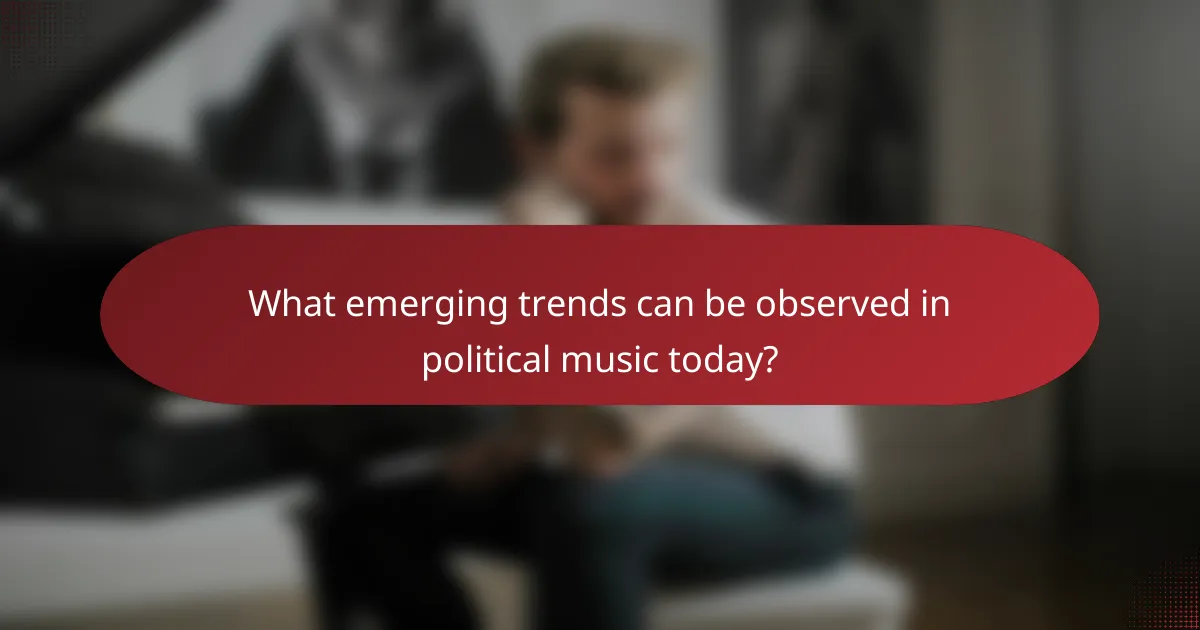
What emerging trends can be observed in political music today?
Political music today is increasingly shaped by the influence of social media and the blending of various musical styles. These trends reflect a shift in how artists engage with audiences and convey political messages, making music more accessible and resonant with diverse demographics.
Rise of social media influencers
Social media influencers play a crucial role in the dissemination of political music, often amplifying artists’ messages to wider audiences. Platforms like Instagram, TikTok, and Twitter allow musicians to connect directly with fans, creating a more personal and immediate dialogue around political themes.
This trend has led to the emergence of viral political songs that can gain traction quickly, sometimes reaching millions of views in a matter of days. Artists who effectively leverage these platforms often see increased engagement and support from younger demographics, who are more likely to share content that resonates with their values.
Integration of diverse musical genres
The integration of diverse musical genres in political music has become a defining characteristic of the current landscape. Artists are blending elements from hip-hop, rock, folk, and electronic music to create unique sounds that appeal to a broader audience while addressing political issues.
This genre fusion not only enhances the emotional impact of the music but also allows for a richer storytelling experience. For example, a hip-hop artist might incorporate folk melodies to evoke nostalgia while discussing contemporary social issues, making the message more relatable across different listener groups.
